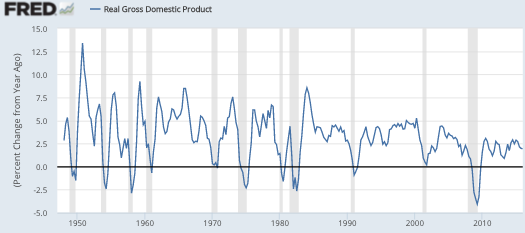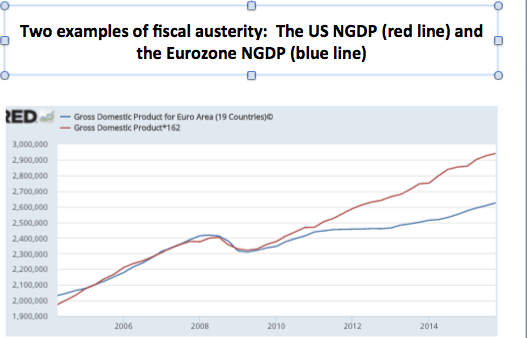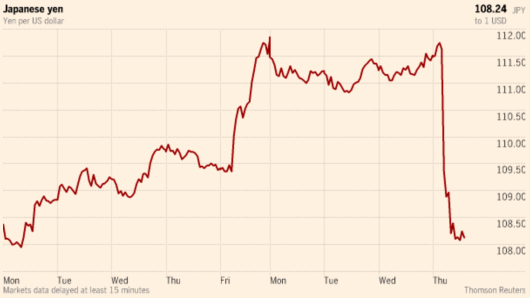Each day my time management spirals more and more out of control. If only there were 73 hours in a day. And now there are new “must listen to” podcasts by Tyler Cowen and David Beckworth. I finally caught up with David’s two most recent offerings. After starting off his podcast series interviewing me, he dug up a couple of obscure economists named John Taylor and John Cochrane.
Not surprisingly, the Taylor interview focused on the Taylor Rule. I have mixed feelings about this rule. I do think that something close to the Taylor Rule (not exactly the same) largely explains the Great Moderation. However, after 2008 I became increasingly disillusioned with this approach, for a couple reasons. First, it’s hard to know what to do when rates hit zero. And second, it looks like the equilibrium real interest rate might be more unstable than we had assumed.
I still favor the concept of policy rules, but would prefer an instrument with no zero bound issues, such as Singapore’s exchange rate instrument, or the quantity of base money, or even better, the price of NGDP futures contracts.
For me, the most interesting part of the interview was the discussion of David’s “monetary superpower” theory of the Fed, which Taylor thought had a lot of merit.
The Cochrane interview was focused on the Fiscal Theory of the Price Level, and not surprisingly I have a lot of reservations about this idea, except for countries like Zimbabwe or Venezuela, where it’s clear the fiscal authorities are the dog and the central bank is the tail. In the US, however, I believe it’s exactly the opposite. Let me respond to a few of Cochrane’s points, and apologize ahead of time if I’ve mischaracterized his views.
1. Cochrane contrasts the FTPL with traditional monetary theories, which imply that a swap of base money for government bonds has important macroeconomic effects. He suggests it’s more like exchanging two fives for a ten dollar bill, just swapping one government liability for another. But if so, why is it that open market operations (OMOs) clearly do have important macro effects? The Fed used OMOs to keep inflation close to 2% during the Great Moderation. Asset markets respond to changes in monetary policy (even before IOR in 2008) in a way that suggests it has powerful effects on the economy. Global stock indices can move 2%, 3% or even 5% in just minutes after an unexpected quarter point change in the fed funds target. And until 2008, those changes in the fed funds target merely reflected the impact of OMOs. So I don’t quite get the FTPL.
2. Cochrane says that in the FTPL the entire future path of government debt matters, not just the current level of debt, and contrasts that with what he calls the M*V = P*Y approach, which (he says) focuses on the current money supply. But in modern monetary models (market monetarist or New Keynesian) the entire future path of the money supply matters for current prices.
3. He doesn’t think 30-year T-bonds are currently a good investment, because he’s pessimistic about our future fiscal policies. And he doesn’t think the Fed would be able to prevent the future inflation that would result from a debt situation that deteriorated sharply. I’m also pessimistic about our fiscal situation, but believe the Fed can offset the effects of deficits. Hence I don’t expect much inflation. My views are consistent with current market expectations, whereas Cochrane seems to have doubts about market efficiency, at least in the case of 30-year T-bonds.
4. I also read the historical record differently than Cochrane. I don’t believe the FTPL can explain either the onset of the Great Inflation, or its end. I don’t believe the common myth that LBJ ran big budget deficits during Vietnam. I would note that LBJ raised taxes in 1968, and yet inflation continued to rise, because it’s monetary policy that drives inflation. I also don’t agree with Cochrane’s view that Reaganomics made the deficit situation look better after 1981, because it increased expected future growth. Reaganomics led to much bigger budget deficits, and so if I had believed in the FTPL, I would have forecast higher inflation in 1981, not the much lower inflation we actually got. Unlike Cochrane, I don’t believe that Reaganomics unleashed a surge in real economic growth, even though I am a fan of Reaganomics, and believe it did lead to higher growth that we would have had under alternative policy regimes.

To clarify, I believe growth rates in many other developed countries fell below US levels after 1982, precisely because their policies were less neoliberal. Thus in criticizing Cochrane’s claims about Reaganomics, I’m actually starting from a much more sympathetic position that someone like Paul Krugman. To summarize, I do not believe that the FTPL offers any explanation for the onset of the Great Inflation, or its end. Monetary policy clearly explains the onset (base growth rates soared), and can also explain the end with a bit more difficulty (money growth was strong in the early 1980s, as lower inflation led to a one time rise in velocity.)
John Cochrane favors the same sort of market approach to monetary targeting as we MMs favor. His specific suggestion was something like Robert Hetzel’s 1989 proposal to target TIPS spreads, although you could also use CPI futures prices. He basically views this as a more sophisticated version of the gold standard, which has always been my view as well. Unlike Cochrane, however, I believe the CPI is essentially meaningless; it doesn’t track anything meaningful in any economic model. (No, it’s not the average price at which stuff sells. The CPI is based on hedonics, which have no role to play in macro.) Thus I think the most useful definition of the “value of money” is 1/NGDP, that is, the share of nominal output that can be purchased with a dollar bill. That’s the variable I want stabilized, along a 3% or 4% per capita growth path. To his credit, Cochrane favors level targeting, and so do I.
Oddly, Cochrane and I end up with fairly similar views on the optimal monetary policy, despite having radically different views on the theory of money. Indeed I favor having the Fed use OMOs with ordinary T-bonds as a way of stabilizing NGDP futures prices, and as far as I can tell Cochrane doesn’t think OMOs do anything. Unless I’m mistaken, Cochrane thinks the gold standard only worked because central banks promised to buy and sell unlimited amounts of gold at the legal price, or at least something other than T-bonds. (To head off objections from George Selgin, you don’t need a central bank; private banknote issuers can also assure redeemability into gold.)
In contrast, I believe the central bank could have pegged the price of gold merely using OMOs with Treasuries. Alternatively, in the 1990s the Fed could have used the Taylor rule without buying any bonds at all. It was the liquidity effect from monetary injections that caused fed funds rates to change, and hence the Fed could have bought and sold gold or zinc to target fed funds prices, and used that instrument to keep inflation close to 2% via the Taylor Rule. In other words, it’s all about the Fed’s liability (base money); the asset side of the balance sheet hardly matters, at least when not at the zero bound, and hence when OMOs are small in size.
PS. Over at Econlog, I have a new post discussing a NBER study that is critical of the New Keynesian claim that artificial attempts to raise wages can be expansionary. Their result supports my claims in The Midas Paradox.
PPS. George Selgin is putting together a very nice series on monetary economics. The second entry discusses the demand for money, and why the price of money and the price of credit are two entirely different things.






